|
1.
CENTRAL/ WEST AFRICA
Unabated demand from Asia drives log prices up
Strong demand from Asia has recently pushed some log prices higher, particularly for the lower B and BC/C
grades preferred by buyers in China and India. Most of West African log exports are now shipped to Far East
destinations, accounting for about 75% of total exports. Robust demand from this region has held prices firm and
on a rising trend over the past 2 years. The heavy rains in
North Congo and Gabon continued in early 2007, longer than usual, resulting in shortages of sapele and
sipo, forcing buyers to pay higher prices for the limited available volume. Demand from China and India is steady
and prices appear set to continue firm through the first quarter.
Sapele prices reach unexpected high levels
Back in 2005, prices for sapele logs weakened after Chinese buyers stepped back from the sapele market.
Subdued demand forced West African exporters to condition sales of other species to the up taking of sapele
logs. However, sapele logs rose throughout 2006 as Chinese buyers returned to the market. Sapele log prices
are now reaching levels roughly similar to those of iroko, a situation that few would have expected before.
New log quota system enters into force in Gabon
The log export quota scheme was introduced in Gabon on 1 January 2007 as planned (see TTM 11:22). Only
producers with completed and operating processing facilities are authorized to export a proportion of their total
log production. Producers that are building but have not yet completed sawmills might be excluded, according to
some reports. Details of each company¡¯s volumes and
capacities have been submitted to the authorities and the allowed export volumes are now being assessed. The aim
is that by 2012, log exports from Gabon will be reduced progressively to only 25% of the total and 75% be
exported as sawn lumber and processed products.
Congo is also planning to implement a log quota system and negotiations with the industry are ongoing. However,
some producers believe that the impact of the new system will be limited for the time being.
Firm demand for sapele pushes lumber prices up
Prices for sawn lumber rose for some favoured species. Strong demand for sapele logs drove prices for sapele
sawnwood up and those for sipo were likely to follow suit. Sapele has enjoyed a firm demand over the last year as a
substitute for the most expensive dark red meranti, which faces tightening availability. Movingui and moabi
sawnwood are also in good demand. Competition from
buyers from Europe and Asia for these species has led to several quite notable price hikes in recent months. Rising
Southeast Asian log and lumber prices and declining supply give West African producers confidence about market stability in the first half of 2007.
Gabon submits scheme for PEFC endorsement
The first ever African national standard, the Pan African Forest Certification System PAFC Gabon, has been
submitted to the PEFC Council for international endorsement. Independent consultants will assess the
Gabonese system against PEFC¡¯s benchmark requirements. Mrs. Rose Ondo, President of PAFC Gabon,
said that the country had more than 10 million ha of commercial forests, offering a wide range of African
tropical hardwoods. He was confident that with a PEFC endorsement, Gabon would be in better position to meet
the growing demand for certified tropical timbers.
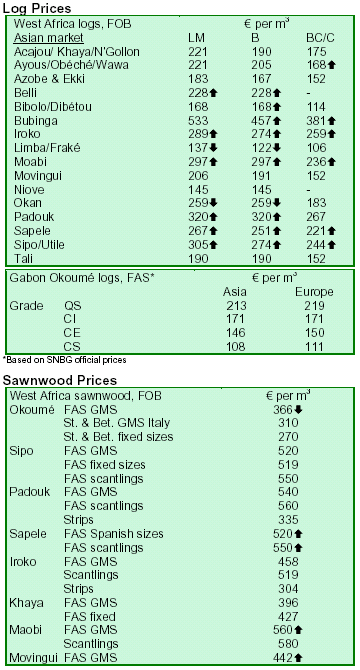
FDA prepares new bidding process for concessions
Liberia¡¯s Forestry Development Authority (FDA) is preparing a new bidding process for logging concessions
following the lifting of a three-year ban on Liberian timber exports by the UNSC. In early 2006, Liberia nullified
some 70 agreements for forest concessions. The new bidding process will start early in 2007, according to FDA
spokesman Richie Grear.
According to Mr. Grear, revenues from timber accounted for 50% of the country's export earnings before the export
ban came in effect in July 2003. Under the new forestry law approved in October 2006, Liberia's forests, which
cover 40% of the country, are to be divided into three categories: protected forests, forests for community timber
activities and commercial logging concessions. The law compels logging companies to provide regular public
disclosure of their revenue while 30% of the earnings from leased timber concessions are to be used for schools,
health centres and other basic social services in local communities.
2. GHANA
Government unveils plans to raise salaries
The government unveiled plans to implement reforms within the public sector, including raises in salaries of
public sector workers, the establishment of a biometrics time and attendance system for workers and a
decentralization programme which will separate the operations of the Office of the Head of the Civil Service
from the Local Government Service to ensure greater productivity. Pay rise was one of the issues that the public
sector workers demanded in 2006. The government will
establish a Fair Wages Commission with full time legally mandated responsibility to administer the new
Comprehensive Pay Structure, maintain its integrity and ensure equity on an ongoing basis.
BoG reports robust economic growth in 2006
The Governor of the Bank of Ghana (BoG), Paul Acquah, informed that 2006 was a good year for the national
economy, despite the shocks the country experienced as a result of high crude oil prices. He said that almost all the
major exports, such as cocoa, gold and non-traditional
commodities, raked in substantial amounts, exceeding the $1 billion mark per commodity. The governor also
announced a reduction in the prime rate from 14.5% to 12.5% as a result of macro-economic stability and the
downward inflation trend. Dr. Acquah said that GDP grew
about 6.2% in 2006 while the year on year inflation declined to 10.3% as of November 2006.
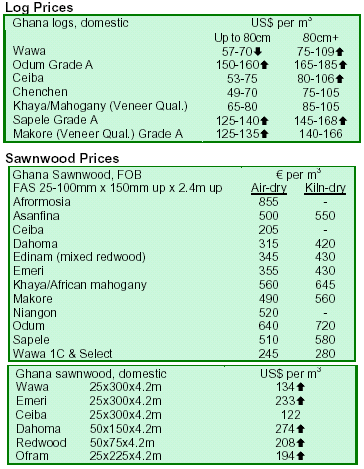
3.
MALAYSIA
Unprecedented flooding sends timber prices sharply up
Last year ended on a sombre note in Malaysia with flooding and torrential thunderstorms raging across most
of the country. A second wave of flooding last week forced authorities to evacuate more than 90,000 people
from their homes in the southern states. Officials reported that the region had experienced its heaviest rainfall in a
century and that the number of people forced to leave their
homes was unprecedented. Johor, a main player in the furniture industry, has been one of the worst affected
states in the country. Parts of the state are without piped water or electricity. The
neighbouring states of Malacca, Negeri Sembilan and Pahang have also been affected.
Pahang is a major source of raw logs and sawntimber. Authorities estimated that the damages could be more than
100 million ringgit. Prime Minister Abdullah Ahmad Badawi said that a state of emergency might be declared if
the floods worsen. The assessment of damages to the Malaysian timber industry is ongoing and may not be
known in three months time.
The incessant rainfall and widespread flooding drove prices for Malaysian timber products sharply up. With
minimal raw material trickling in, stockists of sawnwood and plywood are marking up prices by as much as 25% to
30%. This is an added bonus for some in the timber business as the annual Chinese Lunar New Year draws
near.
EU delegation visits blockade sites in Baram
Malaysia will host an EU delegation in Sarawak in late January to showcase its sustainable logging system and
locally-sourced timber. The 20-member delegation, comprising officials responsible for overseeing EU Forest
Law Enforcement, Governance and Trade (FLEGT), are expected to arrive on 20 January.
Plantation Industries and Commodities Minister, Datuk Peter Chin, said the delegation would be taken to the
Baram area, where semi-nomadic Penans had set up blockades to deter loggers from venturing deeper into
forest areas earmarked as logging concession zones. Mr. Chin explained the government wanted to show that not
the entire Baram area was under the blockade and that
timber was sourced from legally earmarked logging concession zones.
The visit is part of Malaysia¡¯s efforts to formalize the Voluntary Partnership Agreement (VPA) with the EU to
enable its timber products to enter the markets of all the 25-member EU countries (see TTMR 11:19). Mr. Chin
said that the VPA would provide the country a competitive edge over rivals, such as Indonesia, China and Vietnam.
The European market accounts for about 30% or about 2
billion ringgit of Malaysia¡¯s annual timber exports. Meranti, merbau and balau are among the most sought
after timber species in Europe.
Minister urges industry to comply with CE marking
Plantation Industries and Commodities Minister, Datuk Peter Chin, urged industry players to be aware of the latest
developments and changes in the marketplace after opening a Seminar on ¡°International Standards and
Technical Requirements", in Kuala Lumpur. He particularly referred to EU¡¯s extension of the CE Mark to
timber destined for structural use as of 1 September 2007
(see TTMR 11:21). The CE Mark is currently compulsory only for wood-based panel products and floorings. From
September, timber meant for structural use will also have the bear the CE Mark. This implies that Malaysian sawn
timber exported to Europe will have to qualify for the CE
Mark if they are to be used for construction, he said.
He reckoned that although compliance with the CE Mark could be costly, the industry needed to comply due to the
importance of the European market. Mr. Chin added that in order to maintain its market share, the industry would
have to remain vigilant, proactive and innovative of the
requirements in the marketplace.
AHEC says industry cannot live on rubberwood alone
The American Hardwood Export Council (AHEC) held recently a furniture seminar in Kuala Lumpur entitled
¡°Specifying American Hardwood for Furniture Manufacturing¡± to promote US hardwoods in Malaysia.
John Chan, AHEC¡¯s regional director for Southeast Asia and Greater China, said that since Vietnam was fast becoming Malaysia¡¯s biggest competitor in the ASEAN
area, Malaysia needed to upgrade its wood-based furniture products for the export market. According to him,
Vietnam had surpassed Malaysia to become the top importer of US hardwood with $50 million in 2006
compared with Malaysia¡¯s annual imports of $32 million in the last three years.
Although the Malaysian furniture industry ranked number one among Asean countries with a total export value of
about 7 billion ringgit ($1.97 billion) in 2006, Vietnam was approaching it rapidly. However, preliminary
Comtrade export statistics of wooden furniture and parts show that Vietnam ($1.64 billion) may have already
overtaken Malaysia ($1.54 billion) in 2006. Jonathan Gressel, from the US Embassy in Kuala Lumpur, said that
Malaysia had to find niche markets in the US and Europe by improving the quality and recognition of its furniture
overseas with hardwood. He added that the furniture industry could not live on rubberwood alone. Mr. Chan
also said that the value of Malaysia¡¯s furniture products would increase if Malaysian rubberwood was
complemented with varieties of hardwood.
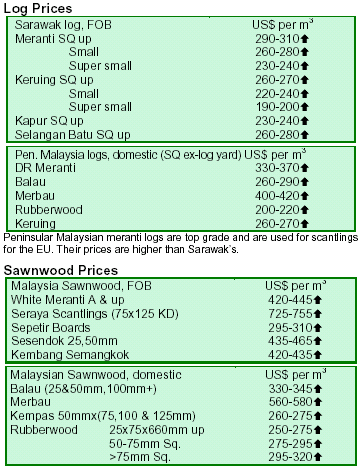
4.
INDONESIA
Indonesia and EU kick off formal VPA talks
The Indonesian Forestry Minister, M.S. Kaban, and Commissioners Louis Michel and Stavros
Dimas, responsible for Development and Environment respectively, met in Brussels on 8 January 2007 and
agreed to initiate formal negotiations towards conclusion of a voluntary partnership agreement (VPA). The VPA is
part of EU¡¯s Forest Law Enforcement, Governance and Trade (FLEGT) initiative aimed at establishing a trading
system and a licensing mechanism to curb the sale of illegal timber products to the EU. The agreement will also
provide for cooperation, including capacity building, market and technical studies and knowledge-sharing.
The move followed a series of informal consultations between Indonesia and the EU over the past year as well
as intensive consultations amongst stakeholders in Indonesia. The EU initiated similar formal VPA talks with
Malaysia in September 2006 (see TTMR 11:17).
Export prices edge up amid storms and police control
The storms and flooding that plagued Malaysia also swept across neighbouring Indonesia. Export prices of timber
products, especially plywood, rose sharply amidst thunderstorms and law enforcement efforts to curb
illegally-harvested timber from reaching the various ports around the country. Armed, uniformed military personnel
were stopping trucks for spot-checks on several highways leading to the major ports.
Indonesian timber merchants think that it is a matter time for Indonesian plywood prices to command the same
levels as those from Sarawak. Currently, Sarawak plywood is riding a boom based on a steady supply-chain
and a reliable transportation system. That advantage may not last for long. The Indonesian government has been
pushing hard to promote foreign direct investment into its infrastructural system.
Indonesia proposes logging ban to prevent floods
A commercial logging moratorium in Indonesia¡¯s critically degraded forests was proposed by the Minister of
Environment, Rachmat Witoelar, following widespread flooding in late December blamed on illegal logging. Mr.
Rachmat said that the ban was necessary because the flooding and landslides were getting out of hand. The
partial moratorium would cover logging in protected areas,
on slopes with a gradient of more than 40%, in places where large trees have been removed and in forests above
human settlements. Mr. Rachmat added that the measure would give time to bring the logging industry under
greater control. He said the moratorium would last from six months to a year and apply to anyone felling trees for
non-personal use.
Any moratorium would have to be signed by Malem Kaban, the Forestry Minister, but Mr. Rachmat was
confident. A similar ban was attempted in 2001 but failed due to some internal problems and poor coordination
amongst the provincial governors, according to Hermono Sigit, a senior official at the Environment Ministry.

5.
MYANMAR
Prices for veneer grade teak logs recover
Prices for teak logs remained firm in the December tender, with veneer grades benefiting from some price gains. The
volume of business conducted was large with direct sales accounting for most of the shipments. Altogether, 58
companies participated in the December tender. Twelve of these companies were from Myanmar and purchased about
17% of the lots tendered for sale. In the sealed tender, 20 companies participated, 12 of which were from Myanmar, accounting for more than 80% of the purchases.
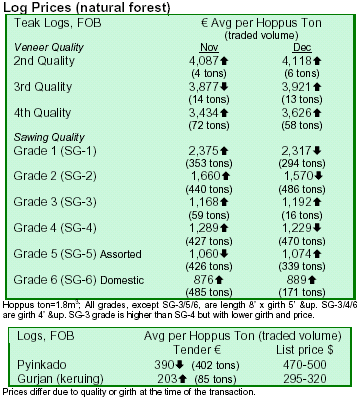
6. PAPUA
NEW GUINEA
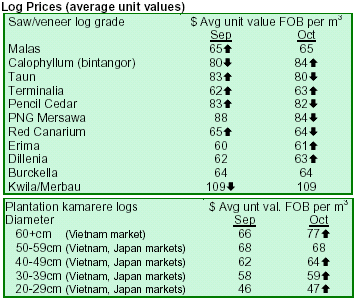
7. BRAZIL
Brazilian furniture exports retreat in 2006
Brazilian furniture exports are estimated to decline 5% to $950 million in 2006, after four years of consecutive
growth, according to the Brazilian Association of Furniture Industry (Abimovel). This is slightly better than
an earlier prediction of a 10% contraction. Four out of the top five importers of Brazilian furniture registered
reductions in imports. Imports by the USA, Brazil¡¯s largest furniture market, dropped 25% to $272.4 million in
January to November 2006. Exports to the UK (up 14% to
$79.8 million in the same period) and Argentina (up 55% to $69.3) were notable exceptions to the declining trend.
Federal government aims at cutting deforestation by 75%
The National Commission of Biodiversity (CONABIO) has set goals and actions to curb deforestation in the next
four years in the Amazon. One goal is to cut deforestation by 75% between 2007 and 2010, reducing to zero the
deforestation in the Atlantic Rainforest and in 50% in
other biomass, with respect to 2002, the base year. Another goal is to ensure that 30% of
non-wood products are certified by 2010. The adoption of these goals is expected to serve as an input for the preparation of the
next Multi-annual Plan (PPA) that the federal government
intends to approve in 2007.
Amap¨¢ increases forest protection areas to record levels
The northern State of Amap¨¢ increased its forest area under protection from 55% to 73% in 2006, the highest
percentage among Brazilian states. Amap¨¢ has several federal conservation units, indigenous lands and protective
forest estate. The state government intends to assign 4 million ha of the newly created areas to solid-wood
companies for sustainable wood production, starting with
1 million ha in the first half of 2007. The objective is to prevent that the largely untouched Amap¨¢ forest areas to
become a focus of illegal logging and uncontrolled deforestation, as seen in some areas of Southern Par¨¢ and
Northern Mato Grosso. Amap¨¢¡¯s geographic location and rough terrain has deterred extractive activities and large
monoculture projects.
The state government recently submitted to the State House a project to create the State Forest Institute that will
manage the forest for at least 25 years. The State has become attractive for forest projects as it presents
institutional instruments to guarantee adequate management.
FSC certifies world¡¯s largest tropical forest area in Brazil
A forest land of 1.5 million ha located in central Amazon received a FSC certificate in
mid-December. The largest certified area of tropical forest in the world is owned and
managed by a group of Kayap¨® tribesmen of the Ba¨² Indigenous Land in south eastern Par¨¢. The Kayap¨® also
received organic certification from IBD for their Brazil nut oil production. A 570,000 ha forest in Guyana for timber
production was until recently the largest FSC certified tropical forest area in the world (see TTM 11:6).

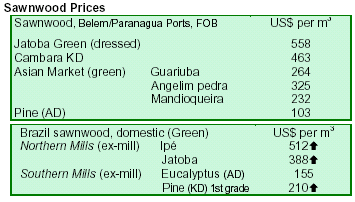
9. BOLIVIA
Growth of wood product exports decelerate in 2006
The Bolivian Forestry Chamber (CFB) estimated that Bolivian wood exports rose 14% to $95 million in 2006.
The growth was below the 18% annual average reached over the previous 3 years. Exports from the northern part
of the country climbed about 30% in the year, offsetting decelerating export growth in the Santa Cruz Region,
which accounts for 50% of the country¡¯s wood products exports. Exports from Santa Cruz grew only 10% compared with 33% last year.

10. Guatemala

11.
Guyana
SFI urges more concessions for small producers
Sustainable Forest Inc (SFI), a consortium of Bulkan Timber Works, Precision Woodworking Ltd and Farfan &
Mendes Ltd, gained approval from the Guyana Forestry Commission (GFC) for a concession of about 32,400 ha.
SFI plans to invest $300,000 to extract and process timber.
The move was part of the government plan to enhance the availability of raw materials to manufacturers who add value to logs.
SFI called for more concessions of 8,000-40,000 ha to be given to 400-500 small forest producers, since these
producers contributed revenues almost equal to the large companies. It said that GFC revenue figures showed that
in 2002, while small forest producers only had 26% of the land, they accounted for 48% of the total revenue. Bulkan
Timber Works informed that, due to a shortage of their prime species (locust or courbaril) over the past year, they
have operated at 40% capacity. It acknowledged, however, that the new concession did not solve the problem as forest
inventories had shown low availability of locust and purpleheart.
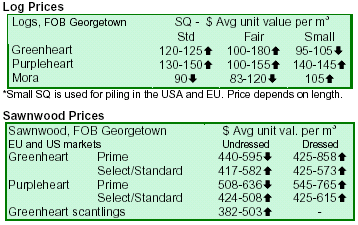
|